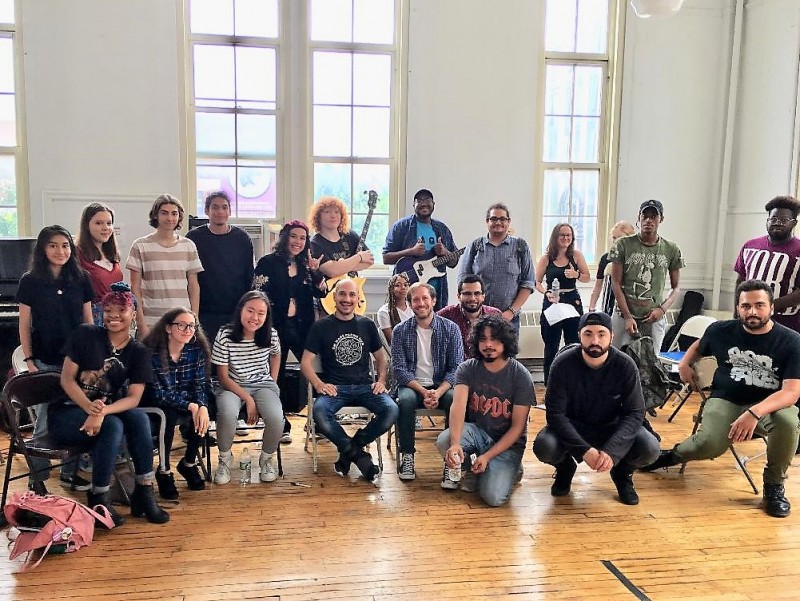Matisse Summer Music and Art Program – Music
This summer, thanks to a grant from the Matisse Foundation, I had the great pleasure of teaching the music portion of the Art for Progress Summer Arts & Music Program for high school students and young adults interested in pursuing creative careers. Consisting of series of four workshops held on Sunday mornings during July and August at the Clemente Soto Velez Cultural and Educational Center, the program was designed to explore the many real-world considerations inherent to careers in the arts and music. The focus was to look at some of the dynamics at play in the music and art worlds, and to provide support in the development of specific skills in the various media. Each week, a professional working in the arts was invited as a guest speaker and to host a short discussion. The speakers were happy to answer questions and were very informative and animated as they enlightened the group about the day-to-day life of a working artist. Everyone seemed to have a great time and to get a better sense of how to approach their work professionally going forward. On a personal note…I had the fantastic opportunity to study visual art in Paris while in college, and later jazz theory and improvisation, so it was auspicious to me to be able to work with the foundation representing French painter Henri Matisse, a personal favorite and early influence. Matisse was known to love American jazz music, and that added to my special sense of personal investment in this project. We at AFP are beyond grateful to them for their confidence and support.
Having taught in high schools and middle schools for the past ten years as an AFP Teaching Artist in Residence, I have always tried to give my students a peek into my adventures as a musician. As a multi-instrumentalist and singer, as well as producer and recording/sound engineer, I’ve seen many different sides of the music industry and of the lives of musicians themselves. It was an honor to have a chance to impart some of what I’ve learned to a group of young people earnestly embarking on their own artistic journeys. The goal, overall, of my contribution to the program was to address the types of things that young people are rarely taught when they are learning to sing and play. The commercial music industry enticingly offers certain motivations, while those rarely align with the way kids learn music, or the experiences of real artists and musicians. I think this program helped people take an important step toward understanding and balancing those dynamics, and to direct their focus toward being well-versed, lifelong artists.
As the head instructor of the music portion of the program, I wanted to share some foundational information and fundamental wisdom in a condensed period of time. Upon arrival, everyone was asked to fill out a survey to select their preferred topics or suggest new ones. I was fortunate to have co-instructors Jason McFarlane, Frank Santiago and for the third week, Elijah McCoy, to help me cover the myriad topics requested. Breaking the sessions into three time segments, each instructor chose from among the most popular topics to cover in breakout groups. Each of the instructors brought a different set of areas of expertise and an enthusiastic personal approach to sharing their experience.
The subject matter was kept broad and the questions were varied. Some of the areas covered included: singing solfeggio (DO-RE-MI…), how scales and chords are built, how to keep stringed instruments in tune, rhythm section interplay; and dealing with interpersonal dynamics in a creative situation. Every week brought a different combination of returning participants as well as new faces, so we had the opportunity to cover some topics more than once, such as basic music theory and how it applies differently to guitar and piano. Other topics were the subject of spirited debate, like how to determine if a creative idea is good and whether it’s worth developing. For the most part, though, the sessions were about bringing to light some of the things that musical artists think about, including: self discipline, skill building and how to practice; making sure you have everything in order for a gig; how to work through self-doubt; and checking your ego.
I feel like we helped all involved to get a better sense of perspective, and to gain some new insight into how to navigate their own path.
The guest speakers: visual artist Artem Mirolevich, trumpeter and producer Albert Leusink, clothing designer Catherine Chang and blues guitarist and singer Michael Hill, each showed the group a window into their view of the life of an artist. Every one of them had a fascinating set of experiences and perspectives to illuminate us about, and they were all completely different. We’re so appreciative to them for openly and honestly sharing their stories and for thoughtfully answering the questions posed.
What was especially remarkable about this program was that, while there were some new people whom we’d never had in an Art for Progress program before; many of the attendees were people with whom I’ve been working for years through school programs, and have watched grow from high school students into young musicians. I have booked and played with their bands, and now consider many of them peers. They welcomed and engaged with the first timers to create a seamless social dynamic. There was also a very fluid interplay between the music room and the visual art portion of the program, creating an environment where creative chances were encouraged to be taken. This really brought home the fact that Art for Progress is an integral part of a growing community of mutually supportive artists. Each person brought their own unique set of interests and abilities, and it was inspiring to see how freely everyone shared and exchanged ideas and techniques. I look forward to the opportunity to host more programs like this in the future, where young musicians can get some useful insight and a new perspective on their craft among a group of similar minded peers, and where this community can have a place to grow organically.
-Barry Komitor





